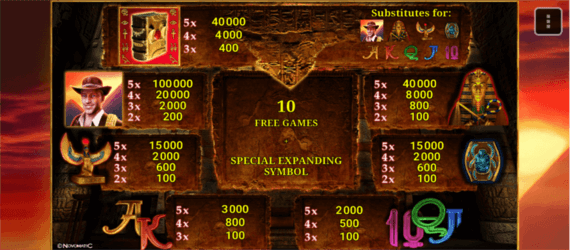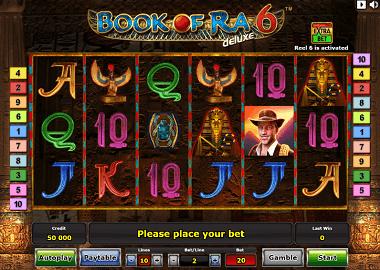Book Of Ra 6 Free Play
Book of Ra slot is one of the first games on this topic. This famous game machine released by the Austrian manufacturer Novomatic gives players a chance to win up to 5,000 credits for each spin. Scatter is the book of the pharaoh. It offers 10 free spins of 5 reels with additional bonus symbols. The Book of Ra free download game pc version is completely free, no need to worry about finding a payment method for a deposit to play the Novoline Book of Ra free download. This version includes a free play mode as well as real money mode. Players can play indefinitely with virtual points (money) generated at will by the casino software.
The new free online video slots book of ra 6 deluxe has finally arrived in online casinos with Novomatic software. The new version promises a lot of fun thanks to the use of 6 reels and a 6 really fun book bonus. By activating the 6 rollers option you will have more chances of obtaining very high winning combinations. Let’s see the characteristics of Novomatic’s new masterpiece.
Technical Features

The online slot machine book of ra 6 rolls is the new online slot that we can offer you in demo version without money. The theme is always the ancient Egypt so much so that in the 6 reels we will find the explorer of Egyptian tombs, artifacts and jewels and the usual values of playing cards from the 10th to the Ace. Graphically the game is identical to the classic book of ra 2 deluxe that you can try for free on our slots games site. The novelty is the addition of the sixth roller which also includes an increase in bets on your part. You will have as many as 6 reels that make the most of the bonus game of the 6 books that we will then describe. Ra’s book is always the magical and mystical object we are going to look for in the hope of winning rich prizes. Another good news is the compatibility of book of ra 6 with all the new mobile devices of the latest generation as an android smartphone samsung, hauwei and iphone.
Bonus Game Free Spins
The Book Of Ra
In addition to the six reels, the game grid offers the classic 9 standard payment lines. The key symbol of the game is Ra’s book. It has a double function. First of all, it is a joker and it replaces all the regular icons to create winning lines. Then it acts as a scatter. If three or more books fall, we will win free spins. We will find ourselves inside the secret chamber of the Piarmide of the God Ra. The book will reveal a random symbol that will be your joker during free spins. If you have activated the sixth roll you will have the chance to win incredible prizes. You can try all the latest and latest Novomatic slots on our demo-free demo site.
Other interesting free slots
The Book of the Dead is the modern name given to the collection of texts the ancient Egyptians wrote to help the dead and guide them through the Tuat (underworld). This collection consists of formulas, hymns, incantations, magical words and prayers. The Book of the Dead is not a work from a single period of ancient Egypt but it is a compilation of writings from throughout Egypt’s history.
Some of the writings combined in the Book of the Dead are:
- The Pyramid Texts
- The Coffin Texts
- The Saite compilation
Modern History of the Book of the Dead
Copies of the Book of the Dead first came to the attention of Western scholars at the beginning of the 19th Century. Grave-robbers found rolls of papyrus with mummies and called them the “book of the dead men” or the “book of the dead.” These titles did not refer to the contents of the scrolls because the robbers did not know what was in them. Instead the names referred to the fact the books belonged to dead men.
Karl Richard Lepius was the first man to translate a complete manuscript of the Book of the Dead in modern times in 1846. He established the numbering system used to distinguish the chapters or spells today. Karl Lepius encouraged other scholars to collect the known variations of all the spells in one book. Edouard Naville undertook this task and completed a three-volume collection of 186 spells. This collection included the significant variations of each spell and his commentary.
Ancient History
The Egyptian name of the collection of works that is the Book of the Dead was the Book of Going Forth by Day. These texts do not record the lives and deeds of the men or women buried in the tombs who owned them. Instead, these texts provide spells to ensure that a soul could pass into the Egyptian paradise through the perils of the Tuat. The Book of the Dead is a compilation of many Egyptian texts of which the Pyramid Texts are the oldest.

The Pyramid Texts are in the pyramids of some of the Old Kingdom Pharaohs and the oldest copy is in the tomb of the 6th Dynasty Pharaoh, Unas. These texts contain essential information for the Pharaoh’s survival and care in the afterlife. The Pyramid Texts identified the king with Osiris and Ra and described him as “honored” by Osiris. These texts stated that his connection to Osiris would allow for the fulfillment of his needs in the afterlife. During this period, only the Pharaoh could have the texts carved in his tomb that would ensure him a good place in the afterlife.
© Tobi Theobald - Book of the dead of Neferini
The Coffin Texts were first compiled during the Middle Kingdom and written from the 18th to 21st Dynasties. Some of these texts were papyrus rolls that could be fifty to one-hundred feet long. Priests carved or painted portions of these texts on coffins and furniture. Each spell of the Coffin Texts received its own title but there was no set arrangement established by the priests. Priests placed amulets carved with portions of the Coffin Texts in certain places on a body to ensure the soul’s well-being.
These texts differ from the Pyramid Texts because they were often used by many members of the uppermost level of society. One series of these texts gave instructions to “assemble a man’s family in the realm of the dead”. This referred not only to close family members of the deceased but also to his/her followers, friends and servants. During this time, families were often buried in the same tombs but they showed social status by the size of different burials.
© Peter Roan - Sarcophagus showing writings from the Book of the Dead
The Saite Compilations of the Book of the Dead was first developed in the 26th Dynasty. It continued in use until the end of the Ptolemaic Period. Wider portions of the population used these texts and included portions of the Pyramid and Coffin Texts. The people standardized the order and number of the spells in the Book of the Dead.
Book of the Dead Spells
Almost 200 chapters or spells exist today but no single compilation discovered to date contains all the spells. Some spells provided information for the dead about the gods, so the dead could identify with the gods. Other spells ensured that all the elements of a soul’s being were safe and reunited into a single entity.
Priests designed spells to protect the dead or to guide them through the Tuat, past the different obstacles on the journey. Most of the extant copies of the Book of the Dead are unique in their choice of spells and order. Scribes organized the Saite compilations into four sections, each of which had a set theme and position.
Chapters 1-16
- The dead person goes into his/her tomb
- The soul passes into the Tuat
- The soul returns so the body could move and speak again
Chapters 17-63
- Explains the myths of the origins of the gods
- Describes places in the Tuat
- Helps the dead soul live and be reborn
Chapters 64-129
- The dead soul travels the sky in the sun-boat as one of the “blessed dead”
- Soul journeys to the Tuat for an audience with Osiris at sunset
Chapters 130-189
- Tells how the dead person becomes one of the gods after his/her vindication before the gods
- Details the protective amulets and food the dead needs
- Describes places in the Tuat the dead will travel through
Book of the Dead Quotes
This quote is a funerary spell that is supposed to be spoken by the living in order to help the dead triumph over their enemies:
'To be spoken over a falcon standing with the White Crown on his head; Atum, Shu and Tefnut, Geb and Nut, Osiris and Isis, Seth and Nepthys being drawn in ochre on a new bowl placed in the sacred barque, together with an image of this spirit (ba) whom you wish to be made worthy, it being anointed with oil. Offer to them incense on the fire and roasted ducks, and worship Ra. It means that he for whom this is done will voyage and be with Ra every day in every place he desires to travel, and it means that the enemies of Ra will be driven off in very deed. A matter a million times true.' - Book of the Dead, spell 134
The following quote gave the deceased the ability to breathe:
Book Of Ra 6 Free Play No Download
O you sycomore of the sky, may there be given to me the air which is in it, for I am he who sought out that throne in the midst of Wenu [Hermopolis]. I have guarded this egg of the Great Cackler. If it grows, I grow; if it lives, I life; if it breathes air, I breathe air.- Book of the Dead

This spell protected the deceased from being slaughtered by Osiris's servants:

My hair is Nu; my face is Ra; my eyes are Hathor; my ears are Wepwawet; my nose is She who presides over her lotus leaf; my lips are Anubis; my molars are Selkis; my incisors are Isis the goddess; my arms are the Ram, the Lord of mendes; my breast is Neith, Lady of Sais; my back is Seth; my phallus is Osiris; my muscles are the Lords of Kheraha; my chest is he who is greatly majestic; my belly and my spine are Sekhmet; my buttocks are the Eye of Horus; my thighs and my calves are Nut; my feet are Ptah; my toes are living falcons; there is no member of mine devoid of a god, and Thoth is the protection of all my flesh. - Book of the Dead, spell 42
Weighing of the Heart
One of the spells in the Book of the Dead describes the “Weighing of the Heart” ritual. During this ritual, Osiris and a tribunal of 43 deities judged the behavior of the dead during his/her lifetime. The dead had to name each judge and vow that s/he had not committed a series of offenses called the “Negative Confession”. If the tribunal found the dead innocent, s/he received the title “true of voice” and could continue the journey. Thoth, the scribe of the gods and the god of wisdom, recorded the results of the tribunal.
© isawnyu - Tomb wall paintings, depicting the weighing of the heart
An image accompanied the written account showing a giant balanced scale with a heart on one tray and the feather of Ma’at on the other. If the heart balanced against the feather, the dead received a place in paradise, the “Fields of Hetep and Laru”. If the heart weighed more than the feather, Ammat the devourer snatched it off the scale and ate the heart. Ammat was an animal who had a crocodile’s head, a big cat’s body and front legs, and a hippopotamus’ back legs.
The Egyptians considered the heart the most important organ in the body. They believed it was the center of emotion, memory and thought. The Egyptians believed that Ammat’s consumption of a heart would cause a dead person to stop existing. The image in the Book of the Dead showing the heart balancing against the Feather of Ma’at guaranteed a favorable outcome. After weighing, the good received his/her heart and other spells ensured that it would remain with the body. Unlike some of the other organs, the heart remained in the body during its embalming. The Egyptians believed its continued presence was vital to the soul’s well-being.
Quick Facts
Book Of One Ra
- The Book of the Dead is not an actual book. It is a collection of mortuary texts.
- It consists of formulas, hymns, incantations, magical words and prayers, believed to help and protect the deceased in the afterlife.
- There are approximately 200 known texts from various periods across ancient Egypt's history.
- One of the most significant chapters depicts the 'weighing of the heart' ritual, where the behavior of the dead during his/her lifetime was judged by the gods.